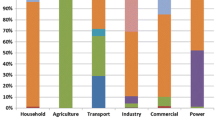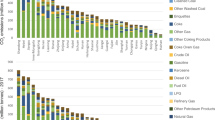Abstract
The quantification of carbon monoxide (CO) emissions is necessary for atmospheric research and has been studied extensively. Aiming to build an inventory with both high spatial resolution and detailed source information, this study estimated the monthly nation-level CO emissions from 79 major sources from 1960 to 2013, based on which a 0.1° × 0.1° gridded emission map was developed for 2011 using a recent energy product. The high sectorial resolution of this inventory can help scientists to study the influence of socioeconomic development on emissions, help decision makers to formulate abatement strategies, and potentially benefit emission-reduction scenario modeling and cost-benefit analysis. Our estimate for 2011 was 888.17 Tg (745.67 Tg–1112.80 Tg), with a much higher contribution from anthropogenic activities (68 %) than wildfire and deforestation (32 %). The anthropogenic emissions in recent years were dominated by developing countries due to the continuously increasing industrial production intensity and/or population explosion. Further discussion of the spatial and temporal variation of emissions was conducted, and a decreased emission intensity was observed, which was attributed to related policies and technological progress.







Similar content being viewed by others
References
An F, Earley R, Green-Weiskel L (2011) Global overview on fuel efficiency and motor vehicle emission standards: policy options and perspectives for international cooperation. United Nations Background Paper: 3
Arellano AF, Kasibhatla PS, Giglio L, van der Werf GR, Randerson JT (2004) Top-down estimates of global CO sources using MOPITT measurements. Geophys Res Lett 31:L01104
Bond TC et al (2007) Historical emissions of black and organic carbon aerosol from energy-related combustion, 1850-2000. Global Biogeochem Cy 21:GB2018
Cao GL, Zhang XY, Gong SL, Zheng FC (2008) Investigation on emission factors of particulate matter and gaseous pollutants from crop residue burning. J Environ Sci-China 20:50–55
Chen H et al (2015) Modeling temporal variations in global residential energy consumption and pollutant emissions. Appl Energy, in press
Clarke L et al (2007) Scenarios of greenhouse gas emissions and atmospheric concentrations (part A) and review of integrated scenario development and application (part B). A Report by the U.S. Climate Change Science Program and the Subcommittee on Global Change Research. 154.
Endresen Ø, Sørgård E, Behrens HL, Brett PO, Isaksen ISA (2007) A historical reconstruction of ships’ fuel consumption and emissions. J Geophys Res-Atmos 112:D12301
European Commission, Joint Research Centre (JRC)/Netherlands Environmental Assessment Agency (PBL). Emission Database for Global Atmospheric Research, release version 4.2 (EDGAR_v4.2) (2011) http://edgar.jrc.ec.europa.eu. Accessed 5 Dec 2013
Fujino J et al (2006) Multi-gas mitigation analysis on stabilization scenarios using aim global model. Intergovernmental Panel on Climate Change 132
Ge S et al (2001) Boiler briquette coal versus raw coal: part I—stack gas emissions. J Air Waste Manage Assoc 51:524–533
Global Fire Emissions Database (verson 4 including small fires, GFEDv4s). http://www.globalfiredata.org/data.html. Accessed 13 Nov 2015
Greenstone M (2002) The impacts of environmental regulations on industrial activity: evidence from the 1970 and 1977 clean air act amendments and the census of manufactures. J Polit Econ 110:1175–1219
Hooghiemstra PB et al (2012) Interannual variability of carbon monoxide emission estimates over South America from 2006 to 2010. J Geophys Res-Atmos 117:D15308
Huang Y et al (2014) Quantification of global primary emissions of PM2.5, PM10, and TSP from combustion and industrial process sources. Environ Sci Technol 48:13834–13843
International Energy Agency (IEA) World energy statistics and balances. http://www.oecd-ilibrary.org/statistics. Accessed 12 Oct 2015
International Fertilizer Industry Association (IFA). http://www.fertilizer.org. Accessed in 13 Oct 2015
Janssens-Maenhout G et al (2015) HTAP_v2.2: a mosaic of regional and global emission grid maps for 2008 and 2010 to study hemispheric transport of air pollution. Atmos Chem Phys 15:11411–11432
Jiang Z et al (2011) Quantifying the impact of model errors on top-down estimates of carbon monoxide emissions using satellite observations. J Geophys Res-Atmos 116:D15306
Jones DBA et al (2003) Potential of observations from the tropospheric emission spectrometer to constrain continental sources of carbon monoxide. J Geophys Res-Atmos 108:4789
Kopacz M et al (2010) Global estimates of CO sources with high resolution by adjoint inversion of multiple satellite datasets (MOPITT, AIRS, SCIAMACHY, TES). Atmos Chem Phys 10:855–876
Lamarque JF et al (2010) Historical (1850-2000) gridded anthropogenic and biomass burning emissions of reactive gases and aerosols: methodology and application. Atmos Chem Phys 10:7017–7039
Liu YQ, Stanturf J, Goodrick S (2010) Trends in global wildfire potential in a changing climate. Forest Ecol Manag 259:685–697
McDonald BC, Dallmann TR, Martin EW, Harley RA (2012) Long-term trends in nitrogen oxide emissions from motor vehicles at national, state, and air basin scales. J Geophys Res-Atmos 117
National Bureau of Statistics of China (NBSC) (2014) China statistical yearbook 2000–2014. China Statistics Press, Beijing
Peter-Stanley M, Hamrick K, Zwick S (2014) The 2013 results report: sharing partner progress on the path to adoption of clean cooking solutions. Global Alliance for Clean Cookstoves, Washington DC
Present and future surface emissions of atmospheric compounds (POET) (2003) http://eccad.sedoo.fr/eccad_extract_interface/JSF/page_deconnect.jsf. Accessed 23 May 2014
Progiou AG, Ziomas IC (2011) Road traffic emissions impact on air quality of the Greater Athens Area based on a 20 year emissions inventory. Sci Total Environ 410:1–7
Reanalysis of the tropospheric chemical composition over the past 40 years (RETRO) (2005) http://retro-archive.iek.fz-juelich.de/. Accessed 13 Oct 2014
Riahi K, Grübler A, Nakicenovic N (2007) Scenarios of long-term socio-economic and environmental development under climate stabilization. Technol Forecast Soc 74:887–935
Seinfeld JH, Pandis SN (2012) Atmospheric chemistry and physics: from air pollution to climate change. John Wiley & Sons, Hoboken
Shen GF et al (2010) Emission factors of particulate matter and elemental carbon for crop residues and coals burned in typical household stoves in China. Environ Sci Technol 44:7157–7162
Shen HZ et al (2013) Global atmospheric emissions of polycyclic aromatic hydrocarbons from 1960 to 2008 and future predictions. Environ Sci Technol 47:6415–6424
Streets DG, Aunan K (2005) The importance of China’s household sector for black carbon emissions. Geophys Res Lett 32
Streets DG et al (2001) Black carbon emissions in China. Atmos Environ 35:4281–4296
Streets DG et al (2006) Revisiting China’s CO emissions after the transport and chemical evolution over the pacific (TRACE-P) mission: synthesis of inventories, atmospheric modeling, and observations. J Geophys Res-Atmos 111:D14306
Su D et al (1998) Harmful gases pollution and its remedy in cement kiln. Chongqing Environ Sci 20:20–23 (in Chinese)
Timilsina GR, Dulal HB (2009) A review of regulatory instruments to control environmental externalities from the transport sector. World Bank Policy Research Working Paper Series. http://ssrn.com/abstract=1368073. Accessed 6 June 2014
U. S. Geological Survey (USGS) Commodity statistics and information. (2014) http://minerals.usgs.gov/minerals/pubs/commodity. Accessed 23 Sept 2015
Uwasu M, Hara K, Yabar H (2014) World cement production and environmental implications. Environ Dev 10:36–47
van der Werf GR et al (2006) Interannual variability in global biomass burning emissions from 1997 to 2004. Atmos Chem Phys 6:3423–3441
van der Werf GR et al (2010) Global fire emissions and the contribution of deforestation, savanna, forest, agricultural, and peat fires (1997-2009). Atmos Chem Phys 10:11707–11735
van Vuuren D et al (2007) Stabilizing greenhouse gas concentrations at low levels: an assessment of reduction strategies and costs. Clim Chang 81:119–159
Wang R et al (2013) High-resolution mapping of combustion processes and implications for CO2 emissions. Atmos Chem Phys 13:5189–5203
Wang R et al (2014) Trend in global black carbon emissions from 1960 to 2007. Environ Sci Technol 48:6780–6787
Westerling AL, Hidalgo HG, Cayan DR, Swetnam TW (2006) Warming and earlier spring increase western US forest wildfire activity. Science 313:940–943
World Steel Association. http://www.worldsteel.org. Accessed 24 Oct 2015
Zhang Q et al (2009) Asian emissions in 2006 for the NASA INTEX-B mission. Atmos Chem Phys 9:5131–5153
Zhao B et al (2012b) A high-resolution emission inventory of primary pollutants for the Huabei region, China. Atmos Chem Phys 12:481–501
Zhao Y, Nielsen CP, McElroy MB, Zhang L, Zhang J (2012a) CO emissions in China: uncertainties and implications of improved energy efficiency and emission control. Atmos Environ 49:103–113
Acknowledgments
This work was founded by the National Natural Science Foundation of China (41571130010, 41390240, 41130754).
Author information
Authors and Affiliations
Corresponding author
Ethics declarations
Conflict of interest
The authors declare that they have no competing interests.
Additional information
Responsible editor: Philippe Garrigues
Highlights
• Global inventory of carbon monoxide emissions was developed from 1960 to 2013 using bottom-up method.
• The inventory was developed with high spatial (0.1° × 0.1°), temporal (monthly), and sectorial (79 detailed sources) resolutions.
• Decreasing intensity trends were found related to energy policies and technology progress.
Electronic supplementary material
ESM 1
(PDF 463 kb)
Rights and permissions
About this article
Cite this article
Zhong, Q., Huang, Y., Shen, H. et al. Global estimates of carbon monoxide emissions from 1960 to 2013. Environ Sci Pollut Res 24, 864–873 (2017). https://doi.org/10.1007/s11356-016-7896-2
Received:
Accepted:
Published:
Issue Date:
DOI: https://doi.org/10.1007/s11356-016-7896-2




